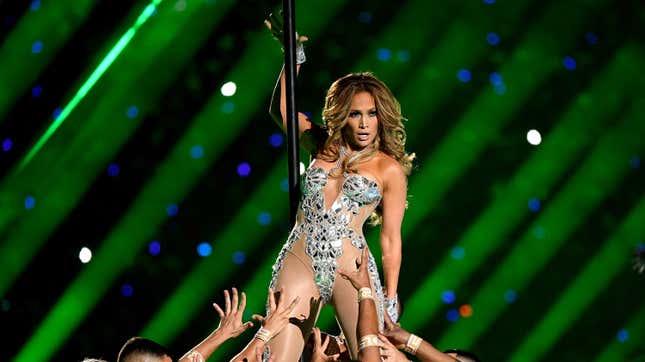The J.Lo Super Bowl Discourse Is All About the Invisibility of Middle-Aged Women
Latest

Today we learned that in the wake of the Super Bowl halftime show, novelist Jennifer Weiner and many of her “middle-age mom” Facebook friends felt personally implicated by 50-year-old Jennifer Lopez’s physique—or, to put it in Weiner’s words, “judged by dat ass.” In a New York Times opinion piece, Weiner waxes in disbelief that “at 50, [Lopez] is a force of nature, a woman who looks so amazing it’s like evolution took a tiny step forward, just for her.” Some of Weiner’s Facebook friends were “in awe” at this alleged evolutionary masterpiece, while others, like herself, also felt the pull of unfavorable personal comparisons.
Weiner’s piece is representative of the jaw-dropped reactions on social media to Lopez’s halftime performance, which are but a variation on the responses last year to her pole-dancing scenes in Hustlers, and both are direct products of middle-aged women’s sexual invisibility. In that halftime show, as with her existence on any stage or screen, J. Lo demonstrates the possibility of being a 50-year-old sex symbol, an older woman on display. There is cognitive dissonance here, because women of her age are so infrequently seen in this way: sexy, vivacious, and worthy of the camera’s zoomed-in gaze.
That leads to the head-shaking disbelief over her appearance, which is a kind of performative shock rarely seen with twenty-something sex symbols whose physiques are similarly exceptional and largely unobtainable, but whom we are utterly used to seeing in this way. (Weiner describes Lopez, with her “silver bodysuit, toned thighs gripping the pole, honeyed locks streaming,” as “looking impossibly … impossible.” Not remarkable, but impossible.) It also leads to unfavorable personal comparisons with a touch of antagonism along the lines of feeling “judged by dat ass” (a phrase certain to provide fodder for academics studying the racialized ways in which Lopez’s body is discussed). Lopez has broken the invisibility rule, thereby ushering in the standards and pressures of visibility.
Of course, invisibility is often a tough pill to swallow. That is the motivation behind all manner of snake-oil youth serums, and possibly the middle-aged woman I recently saw getting fine metal threads sewn into her cheeks to allegedly activate collagen on The Goop Lab. But there can also be some relief in invisibility, in not being so relentlessly watched—by individual humans beings as well as the culture at large. It can feel like permission to step away from beauty routines that previously felt externally mandated. If no one is watching, why perform? Such can be the little-discussed benefits of sliding out of mainstream sexual visibility, as women tend to do in this society as they age.
Middle-aged women are not “supposed to” perform these superficial and commercial signifiers of “sexy,” and certainly not quite so convincingly.
It is difficult, though, to maintain any sense of relief amid the implication that one could be visible, if only one worked harder at it. Weiner writes that “with every birthday, I have asked: Is this the year it ends?” She means: Is this the year when external pressures toward extremely limited aesthetic expectations dissipate? She has personally found that the pressure continued into her 40s (“given Halle Berry and Jennifer Aniston, Brooke Shields and Lisa Bonet”), and now her 50s, thanks to J. Lo and the Super Bowl. But the implied judgement Weiner feels from Lopez’s halftime show, and the so-called “mom drama” that it sparked on her Facebook feed, isn’t just around the typical pressures of physical appearance and age, like wrinkles, weight, and gray hairs. It’s also about Lopez’s expression of hair-flipping, pole-climbing sexiness. Middle-aged women are not supposed to perform these superficial and commercial signifiers of “sexy,” and certainly not quite so convincingly.
Thus, J. Lo is received as both personal affront and “impossible.” In this light, Lopez is first and foremost seen as “a woman flaunting her age in public,” as Vanessa Friedman put it in a separate piece in the Times, as opposed to a woman showcasing her body, voice, or dancing skills.
Weiner writes of coming across a post-Super Bowl meme: “‘50 Years Old in 1985,’ read one side, with a shot of Rue McClanahan from ‘Golden Girls,’ in period-appropriate feathered hair and a dowdy-looking sweater. ‘50 Years Old in 2020,’ read the other side, with Jennifer Lopez in a silver bodysuit…” Weiner continues, “If Blanche Devereaux is now, through some cruel twist of the worst timeline, on the Not side of Hot or Not, I guess Dorothy Zbornak is completely out of the question. And Dorothy had been my plan all along!” (Wikipedia suggests that on the show Zbornak was “mocked as a manly and sexually unattractive.”) She then ends the piece with a shoutout to her “fellow Gen-X ladies” who aspire to Zbornak-hood. “[C]ome sit back here, with me, in your Eileen Fisher tunic and the newish bifocals you haven’t quite mastered. We’ll wait ’til the crowd goes home, and we’ll dance like nobody’s watching.”
Of course, J. Lo suggests that somebody could be watching, and that goes against everything we have been told about women and middle age. This admittedly fills me with ambivalence: It’s the opening up of new pressures, and it’s also an ever-so-slight expansion of possibility and visibility. All I can hope is that one day there will be a choice between more than the limiting dichotomy of a woman “mocked as… sexually unattractive” or a “woman flaunting her age in public,” between Eileen Fisher tunic or reflective bodysuit. Which is just to say: Maybe someday middle-aged women will actually be seen.